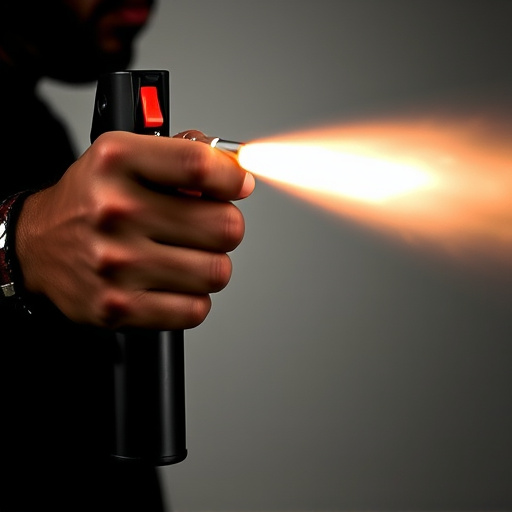Crowd control pepper spray techniques, leveraging capsaicin-based sprays, offer a powerful yet cautious tool for de-escalating high-risk scenarios. Vital aspects include understanding spray composition, proper training on deployment distance and de-escalation strategies, adherence to local regulations, and minimizing harm to bystanders while addressing ethical concerns surrounding its use in civilian hands.
“Discover the power of civilian-grade pepper defense spray, a versatile tool in personal safety. This article explores its composition, effectiveness against potential threats, and strategic deployment as a crowd control technique. We delve into safe handling practices, essential training considerations, and the legal/ethical framework surrounding its use for civil protection. Learn how to make informed decisions regarding self-defense and stay prepared with this game-changing crowd control pepper spray technique.”
- Understanding Civilian-Grade Pepper Defense Spray: Its Composition and Effectiveness
- Crowd Control Techniques: When and How to Deploy Pepper Spray
- Safety and Training Considerations for Using Pepper Spray
- Legal and Ethical Implications of Using Pepper Spray for Civil Protection
Understanding Civilian-Grade Pepper Defense Spray: Its Composition and Effectiveness
Civilian-grade pepper defense spray, also known as oleoresin capsicum (OC) spray, is a popular self-defense tool for individuals seeking effective crowd control pepper spray techniques. Its primary active ingredient is capsaicin, the same compound that gives chili peppers their heat. This potent chemical irritates the eyes, nose, and throat, temporarily disabling an assailant. The composition of civilian-grade sprays typically includes various preservatives, surfactants, and dyes to enhance its effectiveness and user safety.
The effectiveness of these sprays lies in their ability to quickly disperse a fine mist, ensuring broad area coverage. This strategy disrupts attackers’ vision and breathing, providing users with precious time to escape or call for help. Moreover, the non-lethal nature of civilian-grade pepper spray makes it a preferred choice for personal safety without causing permanent harm. Understanding these composition and effectiveness aspects is crucial when considering crowd control pepper spray techniques for self-defense and public safety applications.
Crowd Control Techniques: When and How to Deploy Pepper Spray
When it comes to crowd control, pepper spray is a powerful tool that can be deployed in various scenarios, from public demonstrations to high-risk security operations. Crowd control techniques involving pepper spray should be employed as a last resort when non-lethal force methods have been exhausted or are not feasible. The primary goal is to de-escalate a situation quickly and safely without causing permanent harm.
The effectiveness of crowd control pepper spray lies in its ability to temporarily blind, disorient, and incapacitate individuals, providing an opportunity for order to be restored. Law enforcement agencies and security personnel should receive adequate training on the safe handling, deployment, and de-escalation techniques associated with civilian-grade pepper spray. Proper timing and distance are crucial; spraying from a close range may result in excessive use of force, while deploying it too far might not have the intended effect. Targeting the eyes and face is key to neutralizing an individual swiftly, ensuring the safety of both the crowd and the officers involved.
Safety and Training Considerations for Using Pepper Spray
When using civilian-grade pepper spray for crowd control, safety is paramount. It’s crucial to understand that pepper spray can cause severe discomfort and even temporary blindness, so proper training and precautions are essential. Users must be instructed on safe handling practices, including storing the spray in a secure location and keeping it out of reach of children or unauthorized individuals. Regular demonstrations and refreshers on crowd control pepper spray techniques should be conducted to ensure effectiveness and minimize risks.
Training should cover correct application methods, considering factors like distance and wind direction, to maximize impact while minimizing harm to bystanders. It’s important for users to learn how to respond in case of accidental discharge or if the spray is ineffective, ensuring a safe and controlled situation. Additionally, familiarizing oneself with local regulations regarding pepper spray use is vital to avoid legal repercussions and ensure responsible crowd control measures.
Legal and Ethical Implications of Using Pepper Spray for Civil Protection
The use of pepper spray for civilian protection has sparked debates regarding legal and ethical implications, especially when deployed for crowd control techniques. Legally, many countries have stringent regulations surrounding the possession and use of such substances, often classifying them as firearms or controlled chemicals. This means that citizens must adhere to strict guidelines, obtaining permits and following specific procedures when carrying and using pepper spray for self-defense purposes. Ethical considerations delve into the potential misuse of these powerful tools, particularly in high-stress situations, which could lead to accidental injuries or even fatalities.
Crowd control pepper spray techniques require trained professionals who understand the spray’s impact on human physiology. Improper handling or application can result in excessive force, affecting bystanders or individuals with medical conditions. As such, there’s a growing emphasis on comprehensive training programs that educate users on responsible usage, ensuring public safety while empowering individuals to protect themselves within legal boundaries.
Civilian-grade pepper defense spray is a powerful tool for personal protection, but its use requires careful consideration. Understanding the composition and effectiveness of this spray, knowing the appropriate crowd control techniques, and adhering to safety and legal guidelines are essential. By doing so, individuals can confidently deploy pepper spray when facing threats while navigating the important ethical and legal implications. Embracing these practices ensures a responsible approach to self-defense in public spaces.
